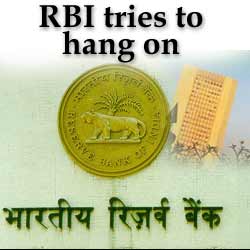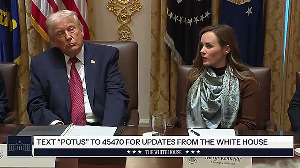
When Ketan Parekh was trading on the market for HFCL, many rational speculators were quite aware that the observed market price was distorted.
Ketan Parekh's efforts to 'contain volatility of the HFCL price' were under constant scrutiny of speculators, who chose to do nothing as long as it was felt that Ketan Parekh controlled enough resources to manipulate the price.
In February 2001, it became common knowledge that Ketan Parekh was himself in financial distress. Suddenly, it became clear that the manipulated price was going to give way to a normal market equilibrium, that the HFCL price was going to fall sharply. What is a rational speculator to do in such a situation? Sell HFCL!
RBI: News and Views
The Capital Market Crisis: Complete Coverage
Across the country, thousands of speculators started selling HFCL and other stocks. Many were startled at these massive waves of apparently coordinated selling.
Sebi has come up with accusations of short selling conspiracies against some securities firms. But such an event does not require co-ordination. It just requires this situation: where many rational speculators independently act on the impending end of a manipulated price.
In the currency market, this kind of event is called a 'speculative attack'. Central banks all over the world have often been at the receiving end of these. It is important to understand that for many months or years, a central bank can sustain a manipulated price.
Rational speculators would sit silently in the sidelines through this period, if they think that the central bank has 'enough' ammunition to sustain the manipulated price.
But when speculators smell that the distorted price will not hold, there will be a rush in the market. This can be a bit chaotic, and central bank often suffer huge losses.
The simplest format in which this happens is when a central bank holds lots of reserves and is sustaining an artificially overvalued exchange rate.
When it looks like there is only (say) $ 5 billion of reserves, speculators expecting that the central bank will not be able to defend the currency after the reserves are finished, rush to convert their money into dollars. As the central bank tries to defend the currency, reserves suddenly go to zero in a spurt of capital flight.
From a current Indian perspective, the interesting scenario is the reverse of this. In January 2003, the Hungarian forint was under such an attack. Speculators were buying up the forint expecting it to appreciate. We call this a 'reverse speculative attack'.
Suppose a central bank is sustaining an artificially undervalued exchange rate. As a concrete example, suppose the market believes that RBI will absolutely not engage in non-sterilised intervention.
In that case, the writing is on the wall. There will be $10 billion or so of further reserves accretion, after which RBI's trading on the currency market will cease.
In this case, we can get a situation where suddenly speculators bring in $10 billion to profit from the rupee appreciation that will follow the end of RBI's manipulation of the market.
This scenario requires that speculators believe that RBI will absolutely not countenance currency trading without sterilisation.
Ironically, even if this expectation is incorrect and if RBI continues to trade in the market, and the rupee continues to rise slowly, the speculator still makes a profit on rupee appreciation. Hence, the present situation may offer a bit of a one-way bet to a currency speculator.
Such conditions could arise in the Indian currency market. One reason for shaping the market's expectations is RBI's track record of keeping money supply under control. Market participants are acutely aware that RBI is highly averse to letting money supply grow at high (over 16-17 per cent) rates.
When faced with making a choice between high money growth and a more appreciated rupee, the RBI may choose to give up on managing the rupee. Such a belief could trigger off a sharp inflow of dollars into the country.
Not surprisingly, the RBI is quite concerned about this problem. It now holds around $10 billion worth of marketable government securities. It recently set up a working group to try to identify new instruments for sterilisation.
The major proposal of this working group is that GoI should issue 'market stabilisation bonds', which would augment RBI's ability to sterilise its foreign exchange intervention. The money borrowed by the government would not be available for it to spend, and would only serve the purpose of sucking liquidity out of the system.
As the report points out, whether the central bank sells its own securities or whether the government sells bonds makes no difference to the cost, to the consolidated balance sheet of the government and the central bank taken together (i.e. the quasi-fiscal cost).
One of the objectives of having MSBs, rather than RBI bonds, is that the loss that RBI makes when it pays out interest on bonds sold for sterilisation would be avoided. Interest payments would be made by the government and show up directly as fiscal costs instead of appearing as reduced RBI profits and lower dividends to the government.
Normally, sterilisation works primarily by impacting the growth of reserve money, which contains two main components: net foreign exchange assets of the central bank and net central bank credit to the government. When foreign exchange assets of the central bank rise, the central bank sells off its holding of government bonds.
In this way, reserve money does not grow at the rate at which foreign exchange reserves of the central bank grow. As its holding of net foreign exchange reserves becomes equal to the monetary base, the central bank loses its ability to impact upon reserve money growth.
When the RBI buys dollars while intervening in the foreign exchange market, it injects rupees into the system. The monetary base expands. The MSB will impact upon money supply by taking rupees out of the economy.
It will be different from other government borrowing in its monetary impact because the government will deposit the money with RBI (rather than spend it, or hold it with commercial banks which puts it back into the economy).
However, if the inflow of capital continues, this exercise will become increasingly expensive. To persuade banks and the public to hold a larger number of bonds, it is likely that a higher interest rate will have to be offered.
This will push up the level of interest rates in the economy as a whole. This works to further attract capital into the economy. Also, issuing a larger number of bonds (even if interest rates are not pushed up) would involve higher interest costs to the fisc.
Will the RBI report act as a signal to the market that RBI seeks ammunition for sterilisation, and thus prevent a reverse speculative attack?
Or, would the report be seen as a warning that sterilisation is becoming increasingly more difficult and expensive, and help set off a reverse speculative attack?
To make matters more difficult, in the coming months India, with her high growth prospects, will be seen as an attractive destination for FII and FDI regardless of the currency story. These developments are going to raise serious challenges for the currency regime.
The author is at NCAER. These are her personal views





